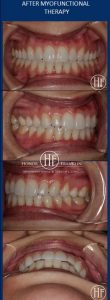
My patient, Sarah, age 30 years, sent me this selfie photo when her orthodontic braces were removed. Look at that gorgeous smile!
“Am I too old for tongue thrust therapy or Orofacial Myofunctional Therapy?”
I get asked this question everyday and the answer is, “Absolutely Not!”
The oldest patient I have seen for orofacial myofunctional therapy (OMT) has been 76 years of age!
Like any other exercise based treatment program, it’s effective for patients of almost any age but I have found success is dependent upon two main ingredients:
- The patient must be able to achieve a patent nasal airway on a consistent basis via an ENT and Allergist evaluation. I have found that nasal airway interference is the primary cause of an OMD and I am fortunate to have an ENT and Allergist on my team who understands Orofacial Myofunctional Disorders and Orofacial Myofunctional Therapy and they are experts at helping my patients achieve a patent nasal airway consistently.
- Patient compliance is imperative. There is no “magic wand”. I do not do anything to you – YOU do the work! Orofacial Myofunctional Therapy (OMT) works specifically on strengthening muscles and creating new habits.
I teach my patients exercises in orofacial myofunctional therapy and the patient goes home and masters them by practicing them three times a day. (i.e. morning, afternoon and evening).
Why three times a day?
In Orofacial Myofunctional Therapy, we are dealing with habit and reduced muscle strength. We are training and strengthening muscles and some of these muscles have never been used before. Muscles don’t have a memory unless you use them. Most of my patient’s muscles are weak and they have habits that are harmful but are strongly ingrained. Repetition strengthens muscles and repetition makes a habit. My goal is to get my patients in and out of therapy as soon as possible so they can go on with their lives and I have found by them practicing their homework exercises 3 times a day, we are able to achieve this goal!
Progress in therapy is gradual ~ again, no “magic wand”~ but my patients will see progress if they are compliant in practicing their homework exercises as prescribed and if they follow the allergist and ENT recommendations.
Throughout therapy, photographs and measurements are taken so my patients can see their progress.
The goal of OMT is to teach a correct oral rest posture of the tongue and lips which means, at rest, the lips should be closed without strain, the patient can breathe nasally on a consistent basis, the tongue is resting against the roof of the mouth not touching the teeth, the teeth are slightly apart and a normal freeway space has been achieved.
This blog is about my adult patient, Sarah.
Sarah was referred to me by a former patient, Shay Lowe-Shull, who wrote a blog about her experience with OMT and me ( I am Doctor #18) entitled, “Fifty Two Shades of Shay: Myofuctional Therapy.”(SEE Mix and Match Mama)
She was also referred to me by her orthodontist, Dr. George Adams at Adams & McBride Orthodontics.
Sarah’s past orthodontic history consisted of a palatal expander, “tongue trainer” appliance to correct her “tongue thrust”, orthodontic braces two times, headgear and retainers.
An Orofacial Myofunctional Evaluation revealed an Orofacial Myofunctional Disorder (OMD) characterized by an incorrect oral rest posture of her tongue and lips consisting of an open mouth, low, forward resting posture of her tongue against and between her teeth resulting in a dental open bite and overjet. In addition, she exhibited a shortened lingual frenum or tongue-tie and an articulation disorder in the form of a lisp.
Since the primary cause of OMDs are nasal airway problems, she was referred to the ENT and Allergist who are part of my team who understand OMDs. The ENT’s evaluation revealed a nasal structural obstruction so she had a septoplasty and nasal turbinectomy as well as a lingual frenectomy. The Allergist’s evaluation revealed strong Perennial Allergic Rhinitis with seasonal exacerbation.
Following her nasal surgery, lingual frenectomy and once the Allergist taught Sarah how to control her allergies, OMT was initiated.
Below are Photos taken at her initial evaluation:

Below are photos taken when OMT was initiated (Orthodontic treatment had been initiated 3 months earlier):

Below are her results After Orofacial Myofunctional Therapy and Orthodontic Treatment:

The photos below show how Sarah presented with an open mouth posture. I asked her to close her lips, as seen in the second photo. (I do this for all my patients because I feel the AFTER photo shows a truer, more accurate representation of improvement when its compared to a closed lip Before photo than comparing a closed lip After photo to an open mouth Before photo).

As you can see, Orofacial Myofunctional Disorders (OMDs) can have a negative effect on the growth and development of the teeth and facial shape but notice the improvement in her teeth and facial appearance following OMT and orthodontics.
NOTE: OMT does not take the place of orthodontics but supports the orthodontic treatment. Restoring a normal resting posture of the tongue and lips and eliminating an incorrect swallowing pattern can assist the orthodontist in aligning the teeth and jaw properly and assist in the stabilization of the teeth before and after orthodontic treatment.
Dr. Honor Franklin of Honor Franklin Myofunctional and Speech Clinic is both an Certified Orofacial Myofunctional Therapist by the International Association of Orofacial Myology (IAOM) and a Licensed Speech-Language Pathologist who has specialized in the treatment of OMDs for almost 40 years. She is the ONLY IAOM Certified Orofacial Myofunctional Therapist in Dallas County and is considered an expert in correcting OMDs.
For more information, go to her website at honorfranklin.com.
Call today to schedule an appointment with Dr. Honor Franklin at Honor Franklin Myofunctional & Speech Clinic 972-233-1312
and Check Us out on Social Media:

THANK YOU! It was a pleasure to work with you!
Comment by drfranklin — May 2017 @ 9:13 am